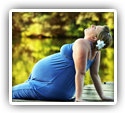
Pregnancy-Related Lumbopelvic Pain Improved with Chiropractic
Print Article

The June 2016 issue of the Journal of Chiropractic Medicine published a case study involving a pregnant woman suffering from pregnancy-related lumbopelvic pain (PR LPP) being helped by chiropractic care.
The study authors note that women suffering with lumbopelvic pain only see care in about 25% of the cases because many believe that the pain is normal during pregnancy. Those who do not gain relief are more likely to continue to have pain after their pregnancy. A previous randomized chiropractic clinical trial showed that chiropractic care given in conjunction with the normal obstetric care was more effective in eliminating pregnancy-related lumbopelvic pain than just obstetric care by itself.
In this case, a 35-year-old pregnant woman presented herself for chiropractic care. She was suffering with moderate pregnancy-related lumbopelvic pain and leg pain. The pain was over both pelvic bones across her lower back. She also reported having an "uncomfortable" tension in her neck and shoulders.
She rated her back and leg pain as a 7 out of 10, with 10 being the worst. The pain started at about the 20th week of her pregnancy and was now radiating down her leg. She reported that standing or sitting for more than 30 minutes, or walking for more than 10 minutes, made her condition worse.
Her history noted that this pregnancy was the result of her fourth in vitro fertilization in a time period of less than 5 years. A previous attempt resulted in the birth of her son. However, two additional attempts to become pregnant resulted in complications and terminated pregnancies.
After an examination, chiropractic care was initiated. The woman was also given some stretching exercises and advised to slowly increase the amount of walking she was doing. Within one week of starting chiropractic care, the woman reported a reduction in the severity and duration of her low back and leg pain. She noted that she was able to sit and walk for longer periods of time.
After 13 visits, she was able to walk or stand for longer than 30 minutes, and sit and travel for more than one hour in the car. This made her daily activities much easier and she reported a decrease in her stress and anxiety. Her overall pain rating dropped from a 7 to a 2 out of 10.
Print Article

